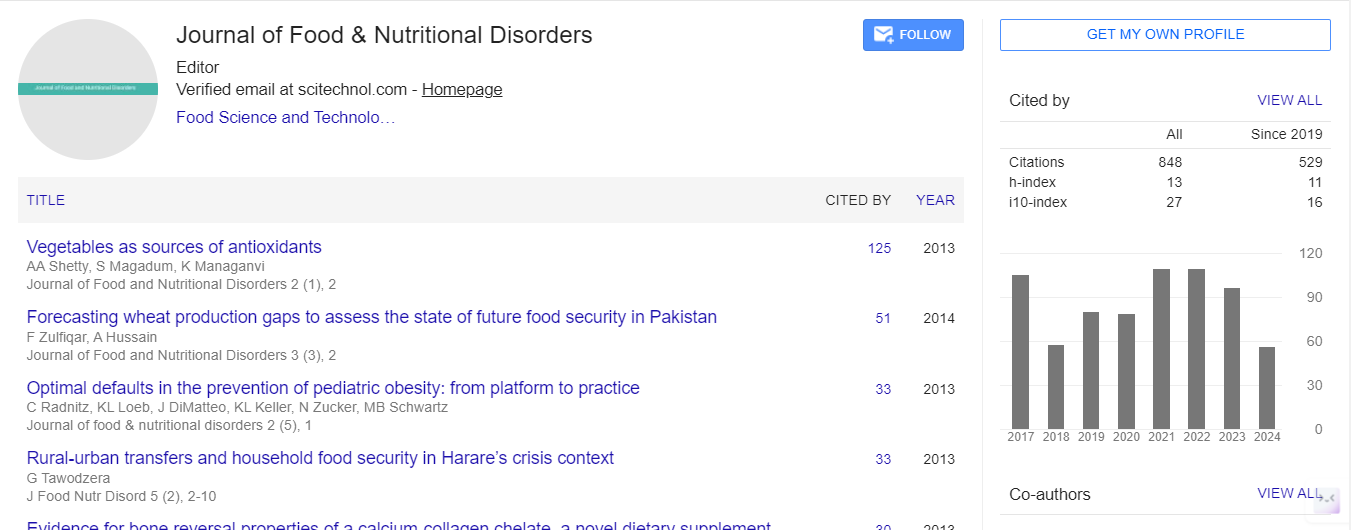Perspective, J Food Nutr Disor Vol: 13 Issue: 6
Body Dissatisfaction and Its Role in the Onset of Eating Disorders among Young Women
Aisha Patel*
1Department of Nutrition, University of Massachusetts, Amherst, MA, USA
*Corresponding Author: Aisha Patel,
Department of Nutrition, University of
Massachusetts, Amherst, MA, USA
E-mail: patelaisha@gmail.com
Received date: 25 November, 2024, Manuscript No. JFND-24-156709;
Editor assigned date: 27 November, 2024, PreQC No. JFND-24-156709 (PQ);
Reviewed date: 13 December, 2024, QC No. JFND-24-156709;
Revised date: 20 December, 2024, Manuscript No JFND-24-156709 (R);
Published date: 30 December, 2024, DOI: 10.4172/2324-9323.1000436.
Citation: Patel A (2024) Body Dissatisfaction and Its Role in the Onset of Eating Disorders among Young Women. J Food Nutr Disor 13:6.
Description
Body dissatisfaction is a prevalent issue among young women and has increasingly been recognized as a significant risk factor for the development of eating disorders. This psychological construct refers to a negative evaluation of one’s body and appearance, which can lead to detrimental behaviors aimed at attaining an ideal body image. Understanding the dynamics of body dissatisfaction and its role in the onset of eating disorders is important for effective prevention and intervention efforts.
Body dissatisfaction often stems from sociocultural influences, including media representations of idealized body images and societal norms that prioritize thinness as an ideal standard of beauty. Young women are particularly susceptible to these pressures due to the pervasive nature of media portrayals of beauty, which often equate success and social acceptance with a particular body type. Research indicates that exposure to thin-ideal media can significantly contribute to feelings of inadequacy and dissatisfaction with one's own body.
This dissatisfaction can manifest in various forms, including negative self-talk, feelings of shame, and a preoccupation with body weight and shape. As young women internalize societal ideals, they may begin to engage in unhealthy behaviors, such as extreme dieting, excessive exercise, or disordered eating, in an attempt to conform to these standards. The relationship between body dissatisfaction and disordered eating behaviors is complex and multifaceted, often serving as a precursor to clinical eating disorders such as anorexia nervosa, bulimia nervosa and binge-eating disorder. Psychological factors play a substantial role in the relationship between body dissatisfaction and eating disorders. Young women who experience body dissatisfaction often exhibit higher levels of depression, anxiety and stress, which further exacerbate their unhealthy eating behaviors. Studies have shown that body dissatisfaction can lead to an increase in depressive symptoms, creating a vicious cycle where emotional distress drives further dissatisfaction with one’s body and the adoption of disordered eating practices.
Moreover, the presence of personality traits such as perfectionism can intensify body dissatisfaction. Perfectionistic individuals often set unattainably high standards for themselves, including expectations around body weight and image. When these standards are not met, it can lead to a heightened sense of inadequacy and an increased likelihood of engaging in harmful behaviors to achieve their desired body shape.
In recent years, social media has emerged as a powerful force that shapes body dissatisfaction among young women. Social media often promote unrealistic beauty standards, leading to increased scrutiny of one’s appearance and self-worth based on physical attributes. Research suggests that social media usage is positively correlated with body dissatisfaction, particularly when users compare themselves to the curated, often edited images of influencers and peer.
The phenomenon of social comparison is particularly pronounced among young women and exposure to idealized images can lead to negative body image perceptions and unhealthy eating behaviors. Social media not only exposes young women to unattainable body standards but can also reinforce dieting culture and normalize disordered eating practices as means of achieving the "ideal" body. Given the significant role that body dissatisfaction plays in the onset of eating disorders, preventative measures are essential. Education and awareness programs aimed at promoting body positivity and selfacceptance can help reduce the negative effects of body dissatisfaction. Teaching young women about the impact of media portrayals and encouraging critical thinking regarding body image can foster resilience against societal pressures.
Additionally, school-based interventions and community programs that promote healthy eating behaviors, physical activity, and emotional well-being can play a vital role in addressing body dissatisfaction. Early intervention aimed at young girls, particularly those showing signs of emotional distress or disordered eating behavior, is important.
In conclusion, body dissatisfaction is a critical factor in the onset of eating disorders among young women. Influenced by sociocultural pressures, psychological factors, and the pervasive impact of social media, body dissatisfaction can lead to harmful behaviors that jeopardize physical and mental health. Addressing this issue through targeted interventions, educational programs, and fostering a culture that embraces body diversity and self-acceptance is essential in preventing the development of eating disorders and promoting the overall well-being of young women. As society becomes more aware of the complex interplay between body image and health, a shift toward body positivity and holistic health can help reduce the incidence of eating disorders and improve the quality of life for many.
 Spanish
Spanish  Chinese
Chinese  Russian
Russian  German
German  French
French  Japanese
Japanese  Portuguese
Portuguese  Hindi
Hindi 
